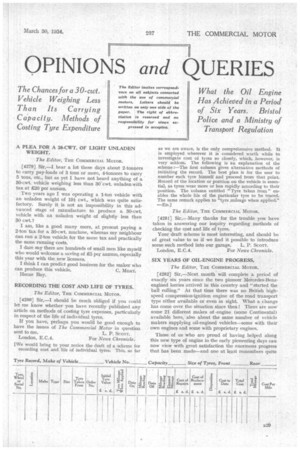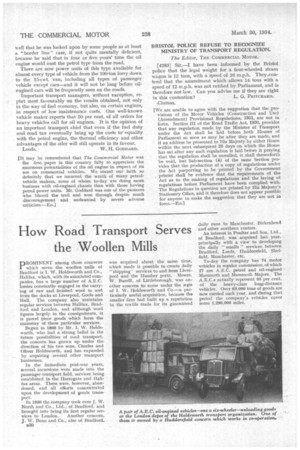OPINIONS and QUERIES
Page 35

Page 36

If you've noticed an error in this article please click here to report it so we can fix it.
The Chances for a 30-avt. Vehicle Weighing Less Than Its Carrying Capacity. Methods of Costing Tyre Expenditure What the Oil Engine Has Achieved in a Period of Six Years. Bristol Police and a Ministry of Transport Regulation
A PLEA FOR A 30-CWT. OF LIGHT UNLADEN WEIGHT.
The Editor, THE COMMERCIAL MOTOR.
[4279] Sir,—I hear a lot these days about 2-tanners to carry pay-loads of 3 tons or more, 4-tonners to carry 5 tons, etc., but as yet I have not heard anything of a 80-cwt. vehicle weighing less than 30 cwt. unladen with tax at £20 per annum.
Two years ago I was operating a 1-ton vehicle with an unladen weight of 19r cwt., which was quite satisfactory. Surely it is not an impossibility in this adyawed stage -of manufactureto produce a 30-cwt. vehicle with an unladen weight of slightly less than 30 cwt.?
I am, like a good many more, at present paying a 2-ton 'tax for a 30-cwt. machine, whereas my neighbour can run a 2-ton vehicle for the same tax and practically the same running costs.
I dare say there are hundreds of small men like myself who would welcome a saving of £5 per annum, especially this year with the new licences.
I think I can predict good business for the maker who can produce this vehicle. C. MOAT. Herne say.
RECORDING THE COST AND LIFE OF TYRES.
The Editor, THE COMMERCIAL /410TOR.
[4280] Sir,—I should be tianch obliged if you could let me know whether you have recently published any article on methods of costing tyre expenses, particularly in respect of the life of individual tyres.
If you have, perhaps you would be good enough to have the issues of The Commercial Motor in question sent to me. L. P. SCOTT.
London, E.C.4. For News Chronicle.
iWe would bring to your notice the draft of a scheme for recording cost and life of individual tyres. This, so far as we are aware, is the only comprehensive method. It is employed wherever it is considered worth while to investigate cost of tyres so closely, which, however, is very seldom. The following is an explanation of the scheme :—The first column gives alternative methods of initiating the record. The best plan is for the user to number each tyre himself and proceed from that point. Record of the location or position on the vehicle is essential, as tyres wear more or less rapidly according to their position. The Column entitled "Tyre taken from" enables the whole life of the particular tyre to be traced. The same remark applies to "tyre mileage when applied."
—ED.]
The Editor, THE COMMERCIAL MOTOR.
[4281] Sir,—Many thanks for the trouble you have taken in answering our inquiry regarding methods of checking the cost and life of tyres.
Your draft scheme is most interesting, and should be of great value to us if we find it possible to introduce some such method into our garage. L. P. Scorr.
London, E.C.4. For News Chronicle.
SIX YEARS OF OIL-ENGINE PROGRESS.
The Editor, THE COMMERCIAL MOTOR.
[4282] Sir,—Next month will complete a period of exactly six years since the two pioneer Mercedes-Benzengined lorries arrived in this country and "started the ball rolling." At that time there was no British highspeed compression-ignition engine of the road transport type either available or even in sight. What a change has come over the situation since then I There are now some 21 different makes of engine (some Continental) available here, also about the same number of vehicle makers supplying oil-engined vehicles—some with their own engines and some with proprietary engines.
Those of us who are proud of having helped along this new type of engine in the early pioneering days can now view with great satisfaction the enormous progress that has been made—and one at least remembers quite well that he was looked upon by some people as at least "border line" case, if not quite mentally deficient, because he said that in four or five years' time the oil engine would oust the petrol type from the road.
There are now power units of this type available for almost every type of vehicle from the 100-ton lorry down to the 15-cwt. van, including all types of passenger vehicle except cars and it will not be long before oilengined cars will be frequently seen on the roads.
Important transport managers, without exception, report most favourably on the results obtained, not only in the way of fuel economy, but also, on certain engines, in respect of low maintenance costs. One well-known vehicle maker reports that 50 per cent, of all orders for heavy vehicles call for oil engines. It is the opinion of an important transport chief that even if the fuel duty and road tax eventually bring up the costs to' equality with the petrol engine, the thermal efficiency and other advantages of the oiler will still operate in its favour.
Leeds. W. H. GODDARD.
[It may be remembered that The Commercial Motor was the first paper in this country fully to appreciate the enormous potentialities of the oil engine in respect of its use on commercial -vehicles. We stated our faith so definitely that we incurred the wrath of many petrolvehicle makers, some of whom to-day are doing more business with oil-engined chassis than with those having petrol power units. Mr. Goddard was one of the pioneers who blazed the trail and won through despite much discouragement and undaunted by severe adverse criticism.—En.]
BRISTOL POLICE REFUSE TO RECOGNIZE MINISTRY OF TRANSPORT REGULATION.
The Editor, THE COMMERCIAL MOTOR.
[4283] Sir,—I have been informed by the Bristol police that the legal weight for a four-wheelect steam wagon is 12 tons, with a speed of 16 m.p.h. They,contend that the amendment which allows 14 tons with a speed of 12 m.p.h. was not ratified by Parliament, and is therefore not law. Can you advise me if they are right in this contention? L. G. PRITCHARD. .Clutton.
(We are unable to agree with the suggestion that the provisions of the Motor Vehicles (Construction and Use) (Amendment) Provisional Regulations, 1931, are not in , force. Section III of the Road Traffic Act, 1930, provides that any regulation made by the Minister of Transport under the Act shall be laid before both Houses of Parliament so soon as may be after they are made, and if an address he presented to His Majesty by either House within the next subsequent 28 days on which the House has sat after any such regulation is laid before it praying that the regulation shall be annulled, it shall thenceforth be void, but Sub-section (4) of the same Section provides that the production of a copy of regulations under the Act purporting to be printed by the Government
, printer shall be evidence that the requirements of the Act as to the making of regulations and the laying of regulations before Parliament have been. complied with. The Regulations in question are printed by His Majesty's Stationery Office, and it therefore does not appear possible for anyone to make the suggestion that they are not in force.---Eo.]












































































